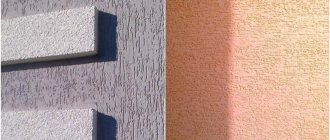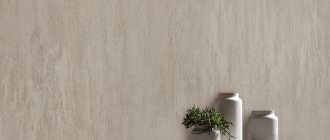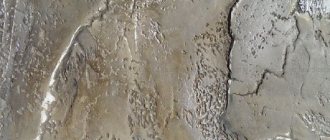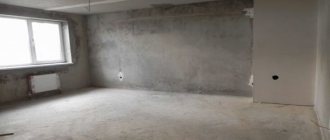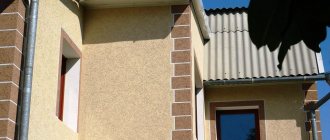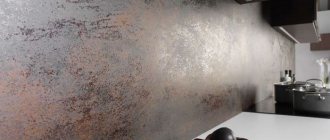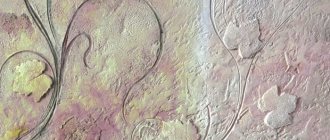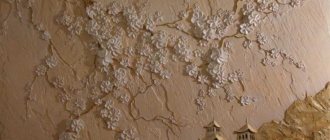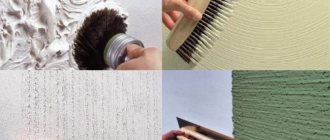Using marble plaster in the interior of a room
Marble plaster is an interesting way of decorating a modern interior to create a luxurious design. The history of the use of this finishing material began in the days of ancient Rome. It was there that for the first time builders decided to use marble chips remaining after processing natural marble. This is how the famous Venetian plaster for decorating imperial palaces appeared. Despite the fact that many centuries have passed since then, decorative plaster with marble chips remains an effective option for wall decoration in our time.
Plaster composition
The material contains marble or granite chips, slaked lime, special binder fillers and mineral pigment. Creating a particularly durable coating is possible using a plaster mixture containing granite chips. If the plaster mixture contains two such important components as granite and marble, then the result is practical, high-quality granite plaster.
It is advisable to use this composition of granite-marble plaster to create the outer plinth of the facade or in places of high traffic, for example, in underground passages.
Types of marble plaster
Marble decorative plaster can be classified into the following types.
Functional purpose:
- Finishing of external facades.
- Creation of interior interiors of residential and public buildings.
Filler type:
- Exclusively marble chips.
- Marble chips with the addition of a granite component.
- Marble chips with lime.
- Acrylic with marble chips.
- Marble chips and cement-sand mixture.
Filler fraction size:
- Fine filler 0.8-1 mm.
- Medium with grain size 1-1.4 mm
- Coarse-grained with a fraction of more than 1.4 mm.
To get the desired visual effect from decorative plaster based on marble chips, you need to know the special technology for its application.
Marble plaster in the bathroom
Manufacturers of mixtures
Textured plaster compositions with marble chips are produced by domestic and foreign manufacturers. Their cost varies widely, but in general it is several times higher than that of conventional cement or gypsum.
The most famous brands:
- Ceresit (German brand HENKEL Bautechnik GmbH) - produces a wide range of affordable facade mixtures (“pebble”), which contain various fractions of other minerals along with marble chips. A distinctive feature of the brand is a 30-year warranty on finished finishing;
- VGT (Russia) – produces ready-made mixtures with a grain size of 1.0-1.5 mm for interior and exterior decoration, as well as auxiliary materials (primers, paints, varnishes, impregnations);
- Bolars (Russia) – the brand’s products are famous for their “Crystal” series, produced with three fractions of marble chips (0.5 mm, 1.5 mm and 2.0 mm). The ready-to-use mixture for external or internal use is packaged in buckets with a capacity of 15, 25 or 45 kg. The material has anti-vandal properties;
- San Marco (Italy) - produces the thinnest variety of ready-made mixtures with 0.4 mm marble chips. Using special paints of the same brand, you can reproduce the effect of a silver or golden patina on the polished surface of the plaster;
- Parade (Italy) - produces paste-like compositions, with the help of which it is possible to obtain a coating with the effect of natural polished marble with a slight touch of patina. The assortment includes mixtures that are varied in structure and decorative capabilities, with universal use and exceptional durability.
For convenience and speed of work, ready-made mixtures are usually used
The cost of the work of craftsmen specializing in Venetian plaster is highly valued - no less than the cost of the material itself. At the same time, you can master decorating skills yourself. Even the most experienced beginner can achieve an attractive result with the help of modern high-tech compounds.
Was this information useful to you? Share in the comments!
DIY marble plaster
The ready-made mixture is sold in any construction stores, but this does not mean that you cannot prepare a mixture for marble plaster with your own hands. Moreover, the price of a ready-made plaster mixture based on marble chips is quite high, it makes sense to make the mixture yourself.
To do this, you will need acrylic putty and two types of coloring pigment, as well as construction equipment: plastic buckets and a drill for mixing with a whisk.
First, the acrylic putty is thoroughly mixed with a mixer until smooth. The resulting mixture is divided into two parts and a certain portion of a coloring pigment of separately dark and light colors is added to each. The result should be a plaster composition that will stick well to the wall and not run off the surface.
There is another more complex recipe for how to make a composition for marble plaster with your own hands. You can prepare a variant of the mixture based on the following components: marble chips and slaked lime in an amount of 1100 ml, soap base 30 g, linseed oil 360 ml, water 180 ml and mineral pigment.
Basic mistakes during preparation and application
The first mistake is non-compliance with technology. Before making a decorative finish, it is often necessary to first level the wall with rough plaster. After this, it is important to wait until it dries completely and then apply a special primer. If you start decorating too early, you end up with unsightly bubbles appearing after some time.
Puttying the walls before their subsequent finishing with Venetian plaster is done with a moisture-resistant composition. This is a mandatory condition, since any ready-made plaster mixture contains moisture. If for some reason you had to use a non-moisture resistant putty, this can be corrected by applying a special deep penetration primer with strengthening properties.
Other common mistakes:
- put the mixture on a spatula in small portions so that its distribution along the wall is smooth and uniform;
- the working surface of a spatula or trowel must be cleaned periodically, since dried fragments will leave untidy grooves on the surface;
- It is impossible to level a dried surface with a spatula; it will only leave deep scratches;
- defects in the design are corrected by applying a new portion of the mixture on top, since coarse sandpaper cannot be used.
Technique for applying homemade marbled plaster
Do-it-yourself marble plaster is not a fantasy at all. The main thing is to make up your mind and carefully study the application technique:
First step. The prepared mixture is scooped onto a spatula and applied in neat small strokes to the selected area of the wall, starting from the top corner. The strokes should not have gaps and should be applied with a spatula in different directions. Upon completion of work, the layer of mixture should dry.
The second step is to sand the first layer with sanding paper. Traces of sanding dust should be carefully removed with a soft brush. Next, you need to create an imitation of natural stone. For this purpose, you need dark-colored putty, which is applied with a spatula at an angle of about 30 degrees to the wall surface and spread in different directions. Chaotic application of strokes creates the desired marble effect. After this, the mixture layer should dry well.
The third step begins by applying a third thin coat of white mixture. The layer is applied very thinly, so that the dark mixture is noticeably visible. After drying, the surface of the third layer is sanded and smoothed with a metal spatula.
Upon completion of the work, the surface of the plaster is covered with a protective coating.
Technology of applying marble plaster
Marble plaster is applied using the ancient technology of Venetian craftsmen, which has remained virtually unchanged since those times. Depending on the desired effect, there are several methods for applying stone chip plaster. Coarse-grained compounds are applied evenly with a spatula over the entire surface without visible transitions or joints, “without lifting your hand.” In this case, the adjacent layers are not allowed to dry out. The coarse-grained mixture can be applied to ordinary “rough” plaster.
Mixtures of medium and fine fractions are recommended to be applied to smooth surfaces treated with a thin layer of putty and carefully sanded. The application of marble plaster occurs in several stages.
Preparatory stage.
At this stage, the surface on which marble plaster will be applied is thoroughly cleaned. Microcracks must be expanded and strengthened with reinforcing tape, and unevenness must be smoothed out with putty compounds. To remove dust from the surface, a deep penetration primer is applied. After drying, you can proceed to the next technological operation.
Second phase
Plaster based on marble chips is applied to a completely dry, flat surface. Coating of decorative plaster is done in the following order: Using a metal trowel and a stainless steel spatula, apply the plaster mixture with sharp strokes and carefully level it.
Half an hour after application, the mixture will dry out a little and then the surface is rubbed smooth with a polyurethane plastic trowel. To facilitate the grouting process, the plastic float is periodically moistened with water. If necessary, the surface of the plaster layer is also sanded.
The plaster layer is dried for two days. It should be noted that high-quality application of decorative plaster is possible at temperatures not lower than +5 degrees. If the temperature indoors or outdoors is lower, shrinkage cracks may appear on the surface of the plaster.
After the plaster has dried, apply the next layer, repeating all operations. For a high-quality coating, it is recommended to apply up to 7 layers of plaster.
After all layers have completely dried, you can proceed to the final process.
When done correctly, marble plaster creates an optical imitation of marble.
Third stage
The essence of the final stage lies in creating a protective coating of the finished marble plaster with wax, which creates a glossy silky effect. Ancient Roman craftsmen used real beeswax for these purposes, and in our time they use synthetic wax, which when applied gives a matte surface.
If desired, mother-of-pearl or sparkles are added to the marble plaster. Acrylic varnish applied in several layers can be used as a protective coating. This treatment perfectly repels dust and creates a waterproof coating.
Video tutorial on applying marble plaster:
Scope of application
Marble plaster is perfect for covering bases that need increased protection from water - plinths, facades, foundations. It is also used to decorate bathrooms, swimming pools, saunas, and baths. The material is plastic and is easily applied to products and surfaces with curves, therefore it is suitable for niches, columns, bay windows, ledges, as well as arches, openings, and any architectural forms.
Plaster with stone chips is widely used indoors. This type of coating is especially popular in cottages and houses with a classic, antique style. However, marble plasters also fit into modern style trends, allowing you to create fashionable details, patterns, and highlight walls or individual stripes or areas. As for base materials, plaster with marble chips ideally fits on surfaces that are not prone to shrinkage:
- brickwork;
- concrete, cement;
- foam blocks;
- cinder blocks;
- OSB, chipboard;
- drywall;
- plastered walls.
Colored shimmer of marble plaster
Colored decorative marble plaster can have a large palette of colors: white, pink, terracotta, gray and even black. If desired, it is possible to create real works of art from marble chips by mixing different colors of the mixture. The plaster imitates red natural marble with white “veins” looks beautiful and unusual.
A new coating option will be a mixture with additives from metal chips, “gold” powder or mother-of-pearl. In the final version, decorative plaster, marble chips, coated with glossy or matte varnish, has the appearance of finishing with semi-precious stones.
Colored marble plaster
Advantages of marble plaster
Plaster in the interior of a private house or apartment, made in any style from classic to modern, serves as an original decor and a real decoration. In addition to high aesthetics, decorative plaster has many advantages:
- High resistance to temperature changes. Thanks to this, marble plaster can be used for finishing external facades.
- Vapor tightness and moisture resistance. That is why decorative marble plaster can be used in “wet” rooms with high humidity levels.
- Ecological purity of the constituent components of marble plaster.
- Strength and resistance to mechanical external deformation.
The unique beauty of marbled plaster
Advantages and disadvantages of finishing with marble
Its numerous positive characteristics speak in favor of choosing this particular decor:
- mechanical strength and abrasion resistance. Facings with granite particles are considered especially durable;
- a rich palette of shades, including the material that can consist of granules of several colors at once;
- vapor permeability, preventing the accumulation of condensation on the walls;
- environmental friendliness - the finish is non-toxic and suitable for decorating any premises, including public buildings;
- the color is resistant to the destructive effects of ultraviolet radiation and does not suffer from precipitation;
- the finished coating is easy to clean from dirt;
- fungi and mold do not settle on the surface;
- does not crack when air temperature fluctuates;
- fire safety – the coating is non-flammable.
To finally settle on this particular method of decorating walls or ceilings, it is necessary to take into account some of its disadvantages:
- under the influence of acids, the plaster may lose strength and/or color;
- the specific gravity of even a thin coating is high due to the presence of a stone component in the composition;
- work with mixtures can only be carried out at air temperatures ranging from +5 to +35°C;
- plastering the facade is allowed only after the shrinkage of the walls of the new building is completed;
- Compared to other varieties, it is a rather expensive type of finishing material.
Scope of application of marbled decorative plaster
Marble plaster is used to decorate the external and internal surfaces of walls. The high plasticity of the mixture allows for high-quality finishing of complex architectural curved elements. The possibility of coloring the filler of the mixture - stone chips - with artificial and natural pigments creates unlimited possibilities for coloring the mixture from black to white.
Decorative marble plaster is an improved traditional finishing material for finishing surfaces. This wonderful option of successful imitation of natural stone allows you to create interesting solutions for non-standard and exclusive design of elegant interiors.
